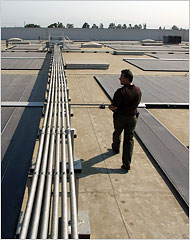Solar Without the Capital Expense
General Motors liked the idea of using the sun to power its buildings. But until recently, one immutable economic fact held G.M. back: The upfront costs were simply too high to justify the ultimate payoff.I like this model. The companies like GM don't need to provide the capital, and a company that specializes in the solar thing can finance it and make a decent rate of return. I am surprised that the electricity is sold for only 10 cents a kWh. There must be some serious subsidies in California for solar. I wonder what kind of rate of return the solar providers make? If the return isn't bad, I wouldn't mind investing in something like that myself.
But now, G.M. and a small but growing number of other companies and municipalities are getting solar energy from systems installed by others. Even though the installations are right on their own roofs, they buy the electricity much as they would from a utility’s grid. And because the companies that paid for the systems will get a steady income, they can provide power from the sun at competitive electricity rates.
A solar developer called Developing Energy Efficient Roof Systems — commonly called Deers — bought the equipment with money it raised from private financiers. Deers and its investors own the cells; G.M. signed a long-term contract to purchase the solar-generated electricity from them, at a discount to the prevailing rate for electricity in the region.
These days, that rate is 9 cents to 10 cents a kilowatt hour; G.M. expects that the solar system will reduce its overall electricity costs by 10 percent a year.
But the same logic underpins all of the deals: The electricity users get a clean, reliable source of energy. The developers and their backers get an equally reliable return on their investment — which can be as high as $6,000 per kilowatt hour of capacity — as well as the tax credits and rebates that California and other states offer for renewable energy projects.
“Corporations like solar energy, but they would rather make sizable investments in their core businesses,” said Craig Hanson, head of the Green Power Market Development Group, a consortium of large companies working under the auspices of the World Resources Institute to promote renewable energy. “But for the financiers, it’s like buying the bond of a triple-A-rated company. It may not offer a 20 percent return, but it’s a stable and secure investment.”
The only thing I wonder is, does it really make sense to put the solar panels on the roof of the building? Wouldn't it be more efficient/cheaper to have a solar farm where you provide electricity to multiple businesses? It seems like it would be easier to build it and to maintain it if it was all in one place rather than being spread out over multiple building roof tops. Then companies like GM could just buy the green electricity being delivered though the grid (possibly by using Green Tags).
But, maybe this isn't the case. Maybe it actually is more efficient to have it on the roof as it no longer needs to be distributed through the grid. Or maybe because you can put the solar panels on a roof for no additional cost vs. having to pay for land it works out cheaper.
I also wonder if they do residential houses, or if they just do commercial. Seems like there would be a similar opportunity with homes, but maybe their smaller size and angled roofs make them more expensive and difficult to make the numbers work.
via NY Times






2 comments:
I suspect they don't have a solar farm possibly for two reasons
-on site solar might be good PR for their clients
-prob'ly more importantly, when they're building on their clients' properties, well... they're building on their clients' properties. They don' have to own any land. Yes, land in the middle of the desert is pretty cheap, but running high voltage power lines out there and everything... Just an idea. And (I'd like to think that) solar panel maintenance isn't particularly high.
Nathan,
I agree with you on the PR.
On the second point, I really don't know. I would love to see some numbers comparing the two. Does the extra cost for land and distribution make centralized solar plants more expensive than decentralized rooftop PVs? I could see it going either way.
Post a Comment
Note: Only a member of this blog may post a comment.